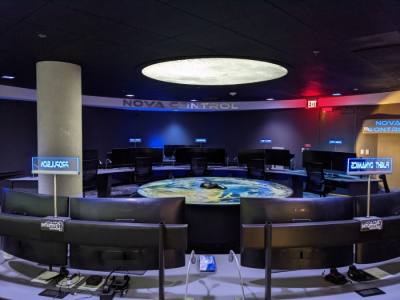The room is dimly lit with a circle of inward-facing computer monitors. In the center of the room is a circular table depicting the Earth, and above it, on the ceiling, is an illuminated image of the moon.
On the wall is a large monitor with the American flag to the left and the Texas flag to the right. Titles such as “mission director” and “flight director” are displayed in glowing blue letters at each console station. In large letters along the circular overhang near the ceiling are the words “Nova Control.”
“It’s very much meant to be more of a collaborative space than the classic NASA mission control with the rows [of chairs and stations] facing forward,” said Troy LeBlanc, the vice president of control centers for Intuitive Machines.
The mission control room, which cost somewhere between $100,000-$200,000 and took about half a year to build, is inside Intuitive Machines’ suite in the Boeing Co. building, 3700 Bay Area Blvd., Houston.
As early as the fall, the room will be manned for 24 hours a day for 22 straight days to operate the launch, flight, landing and mission of Intuitive Machines’ Nova-C lunar lander.
The mission, IM-1, will be the first Houston-controlled mission to the moon since Apollo 17 in 1972, LeBlanc said. It is scheduled to launch from a SpaceX Falcon 9 rocket in Florida this November.
“I was at NASA for 27 years as a civil servant, and I left to come to this company because this is such a cool mission,” LeBlanc said.
The mission is also potentially the first private launch to the moon. Another company—Astrobotic Technology out of Pittsburg—could launch a mission to the moon as early as July, but if it is delayed, Intuitive Machines could be the first, LeBlanc said.
“I hope we’re first. It’d be a really cool thing to tell people that we were the first private company to land on the moon,” he said.
The lunar lander will deliver scientific payloads to the moon to study different aspects of the lunar surface before humans eventually arrive through NASA’s Orion program. The payloads will study everything from the lunar dirt to the moon’s magnetic field to the plume created by Nova-C’s landing, LeBlanc said.
Data from the payloads will be fed back to Intuitive Machines’ mission control room for 12-14 days, after which the lander will be in darkness and power down. In addition to the two weeks the lander will survive on the moon, Nova-C will spend five to six days orbiting the Earth, flying to the moon, orbiting the moon and then landing, LeBlanc said.
“It’ll be high-intensity operations for the first five [days] because we’re going from launch to landing,” he said.
The mission is being done under a contract with NASA’s Commercial Lunar Payload Services Program. The government wanted the work done on the private side so NASA could concentrate on preparing astronauts for trips to the moon.
“They contracted the work and said, ‘You do it because you can move at the speed of business,’ and, you know, government can’t,” LeBlanc said.
The Nova-C lander is under construction at the Houston Spaceport. COVID-19 might hold up manufacturing and other processes necessary for a November launch, but LeBlanc is optimistic.
“There’s a lot to do in nine months to prepare, but we’re getting there,” he said. “So I have high confidence that November’s looking good.”
A year after IM-1, Intuitive Machines will launch a second mission. During this mission, Intuitive Machines will be the first entity to ever land at the moon’s south pole, where an Intuitive Machines lander will drill into the ice to prepare for the arrival of another company’s rover that will explore the south pole. The Intuitive Machines lander will shoot out a “hopper” that will descend into a crater to study it, LeBlanc said.
“That is gonna be sci-fi,” he said.







